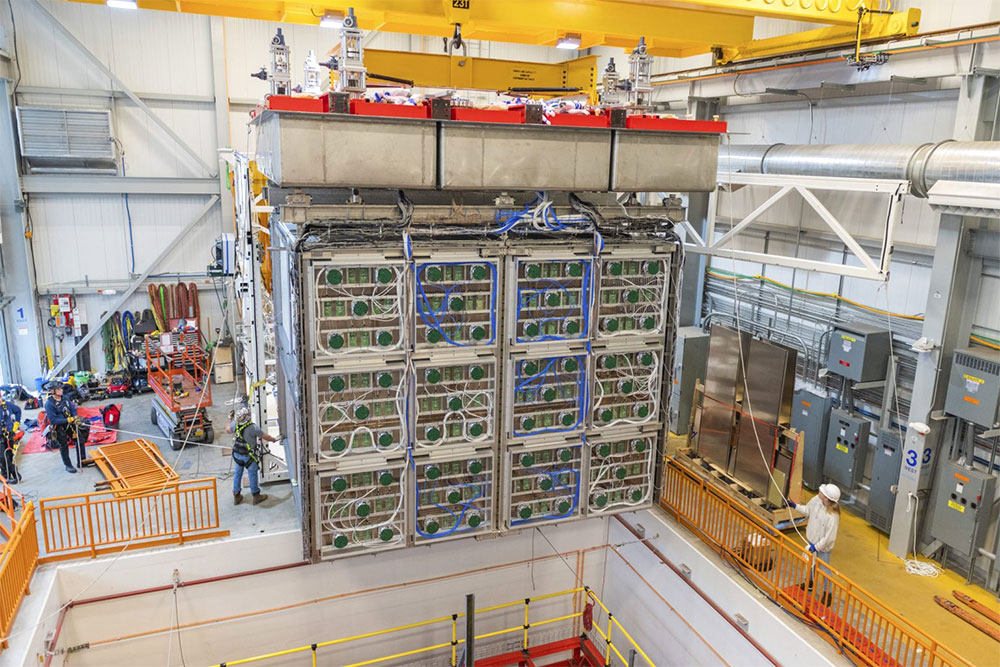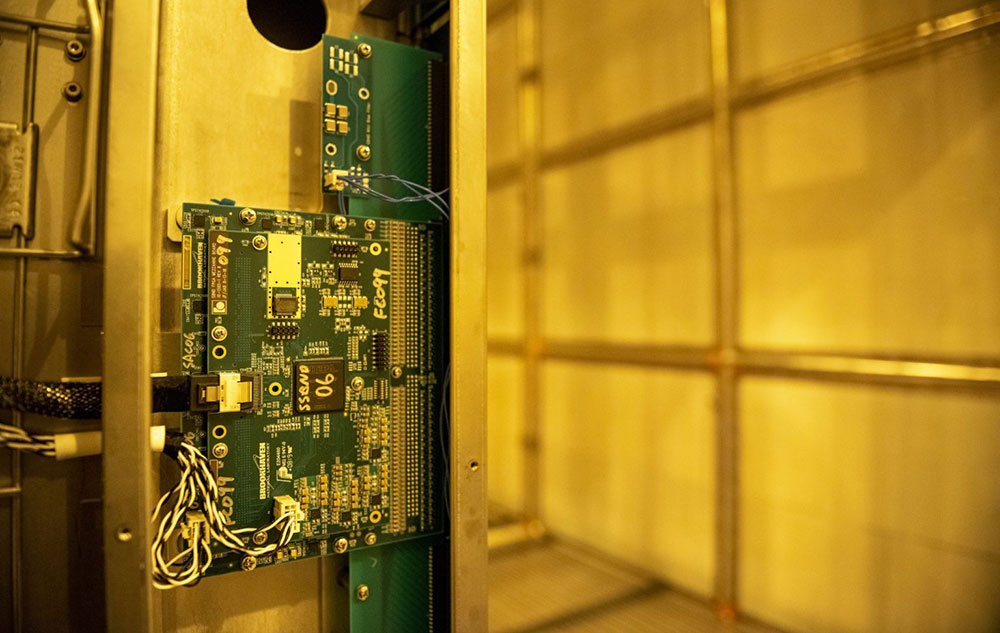Scientists Get Ready to Observe Neutrinos with SBND
February 21, 2024
By Caitlyn Buongiorno, Fermilab Office of Communication
 enlarge
enlarge
Fermilab technicians and members of the SBND collaboration carefully lowered the detector system into the cryostat that will be filled with liquid argon. The move offered one last glimpse of the wire planes that will enable scientists to record tracks of particles emerging from neutrino collisions. Credit: Ryan Postel, Fermilab
The following feature story was originally published by the U.S. Department of Energy’s Fermi National Accelerator Laboratory. Scientists from DOE’s Brookhaven National Laboratory have a long history of contributions to neutrino research, including past and upcoming experiments at Fermilab. For more information on Brookhaven Lab’s many roles in exploring neutrinos — including the Lab’s Physics Department and Instrumentation Division contributions to the “cold electronics” and other electronic detector components that enable this research — contact: Karen McNulty Walsh, kmcnulty@bnl.gov, (631) 344-8350.
The Short-Baseline Near Detector collaboration is preparing for an exciting year at the U.S. Department of Energy’s Fermi National Accelerator Laboratory. After nearly a decade of planning, prototyping and construction, the team is in the final stretch of commissioning of their detector.
In January, engineers began introducing gaseous argon into SBND to push air out of the cryostat. Now that the detector is mostly free of impurities, the team has begun filling it with liquid argon.
“We’re all excited to get to this point. It’s one of the last steps before we see our first particle tracks,” said Roberto Acciarri, the detector assembly and installation co-coordinator for SBND.
SBND is one of two detectors that will collect data in the coming years as part of the Short-Baseline Neutrino Program at Fermilab. Scientists will use SBND and ICARUS to examine the collisions of neutrinos with atoms and search for a new type of neutrino known as a sterile neutrino. A third detector, called MicroBooNE, finished recording particle collisions with the same neutrino beamline in 2021.
“Prior experiments showed hints of a fourth type of neutrino, which is not in line with the Standard Model,” said Peter Wilson, deputy head of the Fermilab Neutrino Division. “The SBN program is aimed at definitively determining whether or not the sterile neutrino exists.”
 enlarge
enlarge
Scientists at Brookhaven National Laboratory designed electronics for SBND that can function even when submerged in liquid argon that has a temperature of -300 degrees Fahrenheit (-185 degrees Celsius). Credit: Ryan Postel, Fermilab
Projecting neutrinos
SBND is a liquid-argon time projection chamber, or LArTPC. Time projection chambers have been used to record particle tracks since their invention in the 1980s.
“You can think of a TPC like a 3D digital camera,” said Acciarri. Where a 3D camera captures multiple pictures to create a 3D image, the TPC captures all the electrons produced in the wake of a neutrino interaction “to reconstruct, in 3D, the trajectory and energy of a particle.”
On one end of the SBND TPC lie three staggered sets of wires on three different planes. A high voltage field inside the detector gives the wires a positive charge. That positive charge attracts the electrons created when a neutrino hits an atom and produces other particles inside the SBND detector.
“Since the detector has an electric field, the electrons will drift towards the array of wires and create a signal on each plane of wires,” said Ornella Palamara, co-spokesperson for SBND. Researchers then combine the three signals and the arrival times of the electrons to create a 3D projection of where the interaction took place in the detector.
Put together, the signals enable the scientists to recreate the paths of the emerging particles and determine the location of the neutrino collision. Based on the strength of the signal, researchers also know how energetic each of the emerging particles was.
However, the size of that signal is very small; it could easily be drowned out by electronics noise both from inside and outside of the detector. SBND scientists are using a relatively new method to reduce that noise.
In early iterations of TPCs, the electronics that identifies and amplifies the signals was located outside of the detector and connected to the wire planes via long, noise-introducing cables. “By moving the electronics inside, you can eliminate those wires and hence that noise,” said Wilson. “The challenge, of course, is designing electronics that can function at liquid-argon temperatures.”
Scientists at Brookhaven National Laboratory have developed so-called cold electronics for LArTPCs and designed the electronics that will be used in SBND to readout the interaction signal. Researchers also successfully deployed this same electronics setup in one of the prototype detectors for the Deep Underground Neutrino Experiment.
The future of neutrino physics
Beyond searching for sterile neutrinos and other unexpected neutrino behavior, SBND also serves as a state-of-the-art training ground for the Fermilab-hosted Deep Underground Neutrino Experiment. Like the Short-Baseline Neutrino Program, DUNE will consist of both a near and far detector, just on a much larger scale.
“The drift technology used in SBND is the same as what will be used in DUNE,” said Palamara. “Young researchers will learn the technology now on SBND and will be then capable to guide the show in the future.”
Once the SBND collaboration has finished filling the cryostat, the team will turn on pumps to circulate the liquid to filter the argon. This will ensure the system remains free of impurities that would prevent electrons from drifting to the sets of charged wires.
“When we start up, that filtering process will be making the argon more and more pure,” said Wilson. “Within a couple of weeks of that, we’ll be in a state where we can turn on the high voltage of the detector and see if everything works.”
Fermi National Accelerator Laboratory is supported by the Office of Science of the U.S. Department of Energy. The Office of Science is the single largest supporter of basic research in the physical sciences in the United States and is working to address some of the most pressing challenges of our time. For more information, please visit science.energy.gov.
2024-21736 | INT/EXT | Newsroom









